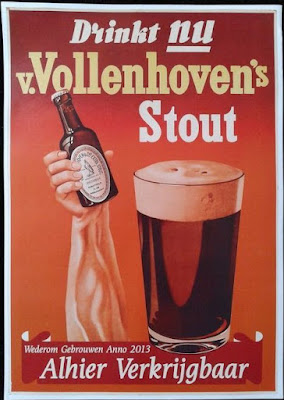A few days ago, Jeff Alworth wrote in a Tweet:
We now accept the rigid classification of beer styles offered by groups like GABF and Cicerone program.
Smart arse that I am, I replied:
I don't accept them. I have my own system of classification.
It got me thinking. What is my system of classification?
I suppose I have written some of them out in the brewery sections of my European Beer Guide website. But they're getting out of date. Which brings me to my second method of classification: by time.
Let's take British beer in the 20th century. There are three distinct periods: 1900-1915, 1920-1940 and 1959-1980. With a bit of chaos inbetween during the two wars.There big differences in examples of the same style in each of the periods.
A second question I asked myself: what are modern Dutch styles? Now there's a tricky one. As recently as 15 years ago, that would have been a relatively straightforward task. A few Lager styles, some Belgian ones, the occasional British-inspired example and a handful of oddities. Way more complicated now, with all this new-fangled craft stuff. Thank Stalin I don't have to attempt the task of classifying them.
The Lager styles I can cope with those. Especially as already done the job for me. Well, most of it.
| Dutch Lager styles around 1960 | |||
| Beer | OG (Plato) | ABV | Description |
| Pilsener | 11º - 12º | 5% | Golden yellow and clear. |
| Münchener | 11.5º - 12.5º | 5% | Less heavily hopped than Pils with a full taste |
| Donker Lager (Oud Bruin) | 8º - 9º | 3.50% | Artificially sweetened |
| Bokbier | 16º | 6.50% | Warm robin-red colour, creamy head and special aroma |
| Dortmunder | 11º - 12º | 5% | Fuller but less heavily hopped |
| Stout | 16º | 6.50% | Especially nourishing. |
| Source: | |||
| "Het Bier is Weer Best", Centraal Brouwerij Kantoor, ca. 1960. | |||
Two of those have since disappeared. Münchener in the 1960s, I think. Maybe a little later. Stout I can remember. That went in the 1990s when Heineken stopped brewing van Vollenhoven's Stout. The beer itself lived on, but in top-fermented form.
On the other hand, I'd add these styles:
| Additional Dutch Lager styles around 2021 | |||
| Beer | OG (Plato) | ABV | Description |
| Light Pilsener | 10º | 4% | More pissy |
| Posh Pilsener | 12º | 5% | Less pissy |
| Gold | 14.5º | 6% | Amstel Gold |
| Meibok | 16º | 6.50% | Pale and tending to maudlin |
| Super Strong | ? | 9-11% | Park bench favourite |
| Source: | |||
| What I see in the shops. | |||
The first type is exemplified by Amstel Blond. Posh is Brand Urtyp or Amstel 1870. Gold is obviously Amstel Gold. But, hang on. Looking at Amstel's website, neither 1870 nor Gold are mentioned. Strike out that Gold category, then. I don't know another example. Apologies for wasting your time.
My park-bench fave is Gulpener Gladiator. A snip at 1.12 euros a half-litre can in Dirk's. An easy drinking 10% ABV, without any rough edges. I much prefer it to Grolsch's 8,6, which is as rough as a badger's arsehole. But sometimes on a special offer that makes it cheaper than Gladiator.
All the Meiboks seem much the same to me: sweet and rather dull. That's why I always stuck to the German beers at the Meibok Festival.
Getting back to styles, I have sort of written style guidelines in addition to the obvious "1909 Beer Style Guide".My period-themed books - "Armistice!", "Peace!" and "Austerity!" - effectively do define styles in their, er, beer style chapters. Between them, they cover the three periods I mentioned at the start of this ramble. Including the years of chaos.
Talking of rambling, a walk is overdue. Time for me to piss off.












































































3 comments:
The Super Strong Park Bench Favorites sound a lot like what we in the U.S. call malt likka. Only they are usually packaged in 24 oz. cans or 40 oz. bottles, and on a park bench, are usually consumed with the containers remaining inside brown paper bags.
A Brew Rat,
here we don't have to bother with that brown paper bag bullshit. At least not around my way. I live in a nice area.
I was worried that Alworth was suggesting that beer styles were actually solidified, but then I read this piece and relaxed:
https://www.beervanablog.com/beervana/2021/8/26/the-language-of-style
I think the word "vaporousness" that he used is right -- it's like trying to define clouds, and outside of a few broad categories you quickly end up with a lot judgment calls based on shifting situations; what matters about a cloud to a meteorologist is different from what matters to a sailor or a photographer.
I think a big problem underlying a lot of the arguments is the tendency of some people to think biologically instead of historically. There is a tendency in some parts to talk about evolution as if there is some kind of genetic exclusivity based on inherited traits, when the reality is one country has a revenue crisis and the next thing you know ABVs have plunged across the board. You can't selectively breed a duck from a dog, but there is nothing to stop a beer experimenter from using an English yeast, American hop and German malt, along with cherry juice and vanilla.
Post a Comment